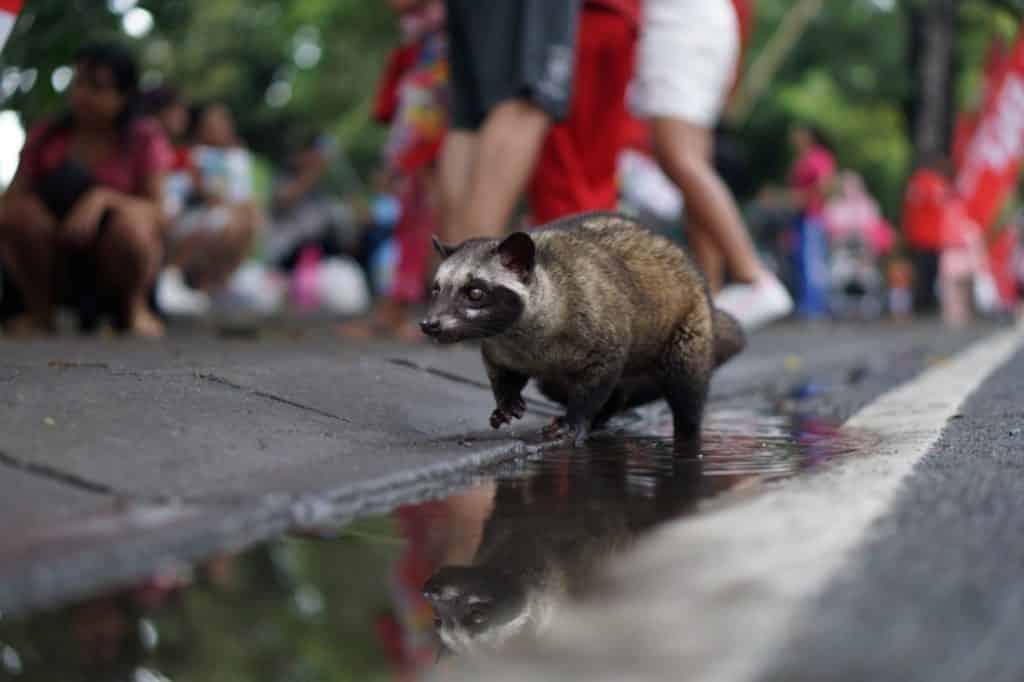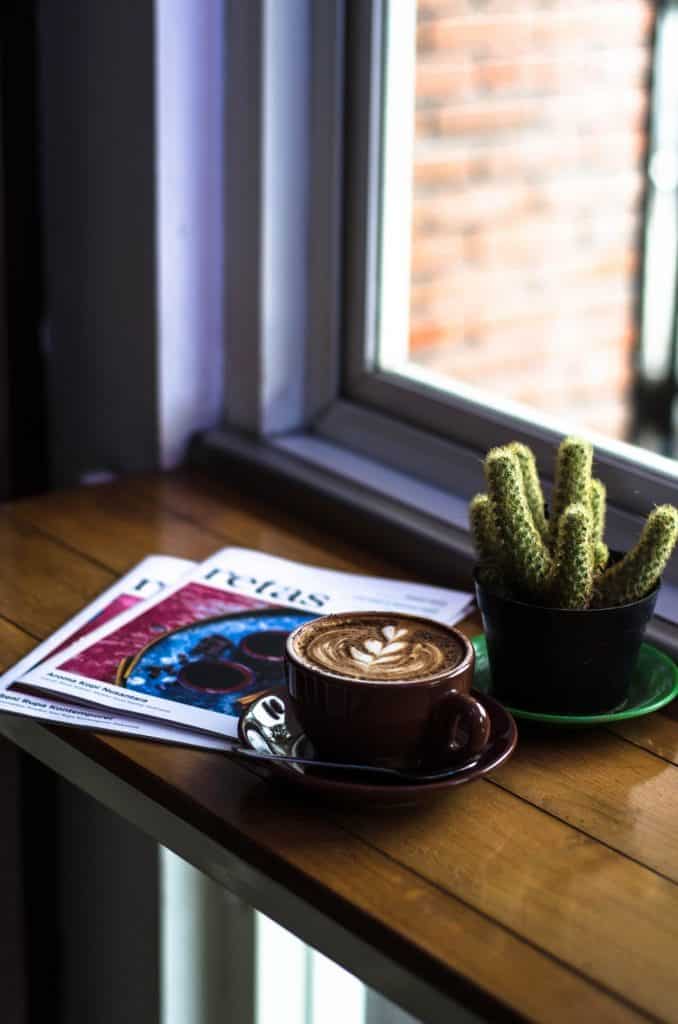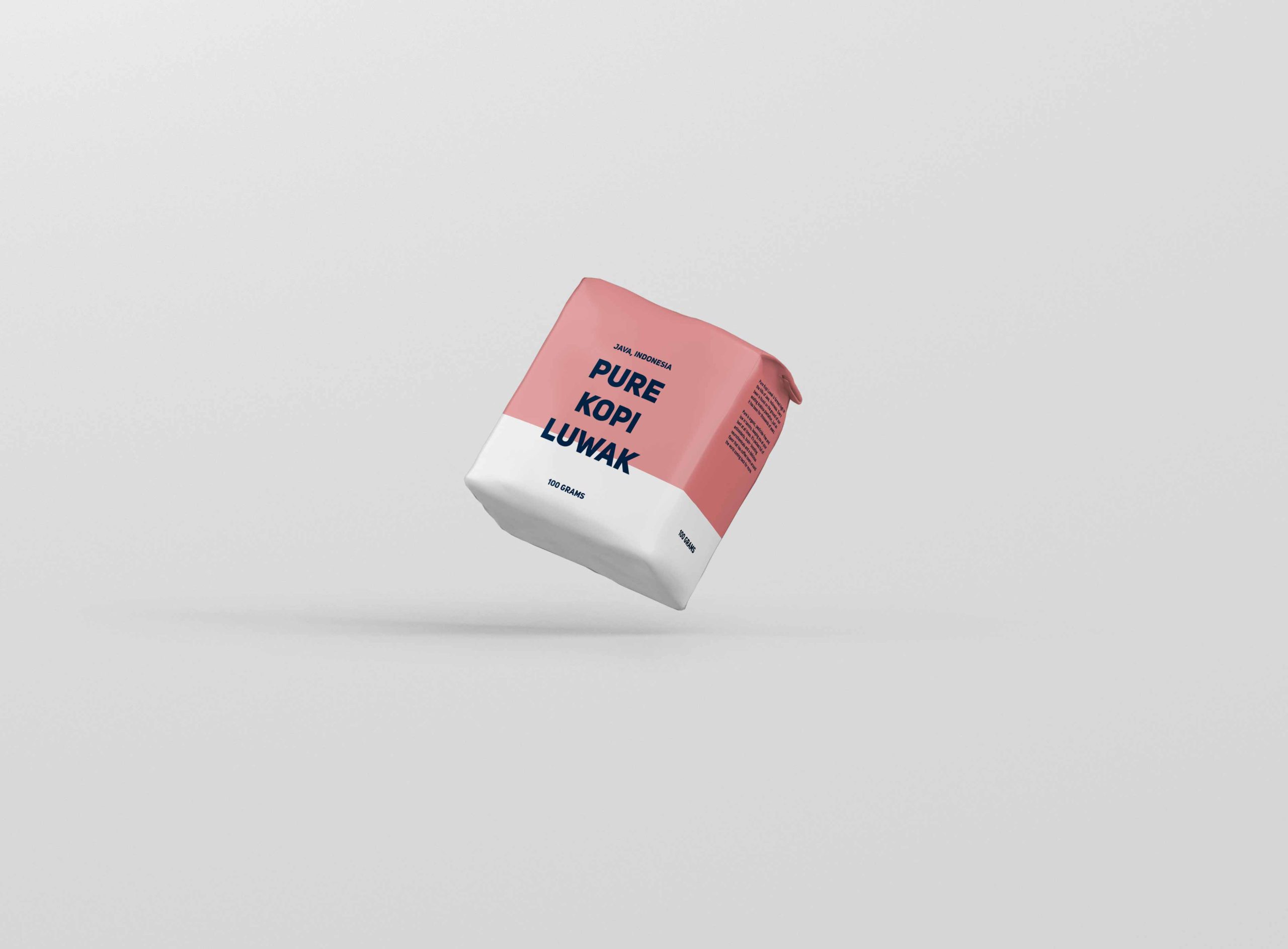If you’re a coffee lover, you’re bound to have heard of civet coffee, either by that name or by its original name, kopi luwak. You’ve probably also wondered what makes this sort of coffee different from all the rest, and why it’s known to be the most expensive coffee in the world. In this article, we’ll give you everything you need to know about civet coffee (a.k.a. kopi luwak), including links to all of our posts on the various details that make civet coffee the top choice for coffee lovers seeking a distinctive, exotic flavor combined with more health benefits than any other coffee on the market.

Civet coffee is made from beans digested and defecated by the Asian palm civet cat.
What Is Civet Coffee?
Civet coffee is a special kind of coffee prepared from coffee beans that have been eaten, digested and defecated by the Asian palm civet cat (known in Indonesia as the luwak), a small cat-like mammal that enjoys eating ripe, luscious coffee cherries. The pooped-out coffee beans, protected by a thin parchment because digestion doesn’t destroy the bean’s tough outer husk, are then washed, dried, husked and roasted to make for a delicious cup of coffee. The special thing about civet coffee is the fermentation process that occurs in the digestive tract of the civet, which gives civet coffee a uniquely desirable taste and aroma and cuts its caffeine content in half when compared to any other cup of joe.

Jack Nicholson certainly loves his Bucket List coffee, more commonly known as civet coffee or kopi luwak.
Civet coffee is a type of fermented coffee produced mainly in southeast Asian countries like the Philippines, Vietnam and Indonesia. To make things confusing, each country has given civet coffee its own name: the original name, kopi luwak, stems from Indonesia, and is a literal translation to civet (known locally as the luwak) coffee (kopi). In Vietnam, it’s called cà phê chồn, the first two words meaning coffee and the third being a term used for mink, ferret or weasel (the civet is actually more closely related to the weasel than to the cat). Finally, in some of the Philippine islands it’s known as kapé alamid or kape motit. Thanks to the great 2007 film starring Jack Nicholson and Morgan Freeman, civet coffee is also known to some as Bucket List coffee. Some people even call it cat poop coffee, for obvious reasons.
What’s So Special About Kopi Luwak?
Kopi luwak has become famous for several reasons aside form its price, exoticity and Jack Nicholson. Some of these reasons include its excellent taste, aroma and health benefits. Some of these characteristics are common to all fermented coffees, whereas others are unique to kopi luwak:
- Taste of civet coffee: Kopi luwak is less bitter than regular coffees, and it’s been described by professional cuppers as earthy, syrupy, smooth, and rich with chocolate and jungle undertones.
- Health benefits of civet coffee: These include higher levels of inositol (which improves the effects of neurotransmitters, fights polycystic ovarian syndrome, combats depression and more), higher levels of citric acid (which avoids kidney stones, osteoporosis and more) and higher levels of malic acid (which boosts your energy).
- Half the caffeine of other coffees, which gives you plenty of energy without the caffeine crash
- Far fewer tannins, making civet coffee much healthier for your teeth
- Less likely to produce coffee heartburn

Civet coffee is delicious no matter how you drink it.
Some people find the idea of brewing civet coffee too exotic (let alone drinking it) but before you think about passing on kopi luwak, consider these important facts:
- Fact #1: Every coffee in the world undergoes some kind of fermentation before it reaches your cup. The only difference with civet coffee is that this fermentation process occurs inside the civet’s belly.
- Fact #2: Pure Kopi Luwak beans are thoroughly washed multiple times, and the roasting process kills or destroys any possible pathogens (harmful substances or bacteria) that might have escaped the washing, making civet coffee perfectly safe to drink. Indonesians have been drinking kopi luwak for centuries—and loving every cup!
- Fact #3: Putting your imagination aside, civet coffee doesn’t taste “strange” or “off.” It still tastes like coffee only sweeter and, according to most people who try it, better.
There’s a reason why people all over the world are willing to pay more for civet coffee—trying kopi luwak at least once in a lifetime should be on any coffee lover’s bucket list. Try Pure today.
The History Of Kopi Luwak: When And How Was Civet Coffee Discovered?
Whether you’ve heard of civet coffee or kopi luwak before or not, you’re probably wondering how we came to discover such a unique and wonderful brew. To answer that, we need to dip into the annals of history.
Civet coffee came as a byproduct of the 19th-century Dutch empire. At that time, the Dutch implemented a system known as the cultuursteisel, which is Dutch for cultivation system, with the purpose of increasing revenue in the Dutch East Indies (current Indonesia). To increase their export earnings, the landlords in colonial Indonesia forbade local coffee farmers from picking coffee for their own consumption. In a desperate attempt to acquire coffee without been punished, farmers began to pick coffee beans from civet droppings, cleaning and processing them as they normally did with regular coffee beans. To their surprise, the “civet coffee” tasted better than what they were drinking before, so the unusual brew became a sort of fad amongst farmers.
When the Dutch landlords took notice, they dug into the type of coffee the farmers were drinking, thinking that there was theft involved. Their discovery led to an entirely new category of export, with a price that quickly skyrocketed on global markets. As it turns out, the world can’t get enough kopi luwak.
In modern times, kopi luwak was again thrust before the masses thanks to a featured article in the March 1981 issue of National Geographic Magazine, Ethel A. Starbird’s Coffee, The Bonanza Bean.

National Geographic Magazine, March 1981 issue featuring one of the first western culture articles on Kopi Luwak: Coffee, The Bonanza Bean, by Ethel A. Starbird
In the piece, Starbird tells her story of unknowingly tasting kopi luwak for the first time. As the story goes, Starbird’s host, an Indonesian farmer, had told her about a particular type of coffee first digested by the civet cat; when she expressed her desire to try the exotic drink, her host informed her that she just had. The international reach of Nat Geo Magazine stirred the curiosity of many, and contributed to kopi luwak’s widespread allure.
Over the years, demand for civet coffee has pushed people to do unscrupulous things. Farmers passed regular coffee off as kopi luwak. Caged kopi luwak popped up, and is still rampant (note: Pure is 100% wild). Synthetic kopi luwak came about, too. Let’s take a look at both of these in turn.
Wild Kopi Luwak vs. Caged Kopi Luwak
Wild kopi luwak is just what it sounds like: the coffee beans are collected from the droppings of wild civets. This is in sharp contrast to caged kopi luwak, which comes from civets kept in cages and bred as farm animals.
Buying Tip: If kopi luwak isn’t advertised as 100% wild, then it’s definitely not.
Buying wild kopi luwak is a critical component in building an ethical, sustainable supply chain. We work with a certified 100% wild kopi luwak plantation in Java, which has built its decades-old business around the civets’ natural habitat. It’s the only way we do business.
Quality Differences
Wild civets are free to choose what they eat, so they only go after the ripest, most delicious coffee cherries they can find. Caged civets, on the other hand, are usually force-fed both good and bad cherries, meaning the resulting coffee isn’t nearly as tasty.
Ethical Differences
Wild kopi luwak production has zero impact on the civets themselves—farmers simply collect the civet droppings and don’t interact with the civets at all. Caged kopi luwak, though, has faced plenty of pushback from wildlife protection agencies and animal rights activists alike. Caged civets live in terrible conditions with a very unnatural diet consisting of almost entirely coffee cherries.
Be responsible in your kopi luwak choice. Drink 100% wild kopi luwak. Drink Pure.


Ivy
Hi,
How much is the the civet coffee? Do you ship it to china? How long does it take?
Is your civet coffee 100% wild? How do you guarantee that you can get enough amount as it all depends on whether the farmers can find the drops by civets?
Thanks,
Ivy
admin
Hi Ivy,
Yes, our kopi luwak is 100% wild and is sourced in the mountains of Java, Indonesia. As you’ve mentioned, we don’t have a limitless supply, but right now we do have a small but consistent supply of kopi luwak that meets our customers’ needs. As long as our website doesn’t say “Out Of Stock”, we have some for you.
Our current batch of kopi luwak costs $140 USD for 100 grams (https://www.purekopiluwak.com/product/pure-kopi-luwak/) or $300 USD for 250 grams (https://www.purekopiluwak.com/product/pure-kopi-luwak-250/). We ship express to every country in the world, including China, and it generally takes about 5-7 business days to arrive (~2 days if you’re in the United States).
We hope you enjoy yours!
Pure